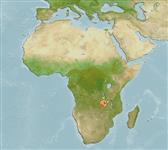Classification / Names
Common names | Synonyms | Catalog of Fishes (gen., sp.) | ITIS | CoL | WoRMS | Cloffa
Actinopterygii (ray-finned fishes) >
Siluriformes (Catfish) >
Amphiliidae (Loach catfishes) > Doumeinae
Etymology: sagitta: relative to that of its congeners; a noun in apposition (Ref. 88958). More on author: Vari.
Environment / Climate / Range
Ecology
Freshwater; demersal. Tropical, preferred ?; 10°S - 13°S, 29°E - 32°E
Africa: upper Congo River basin, specifically in tributaries of Lake Mweru, the Luongo River and the Chambeshi River, Zambia (Ref. 88958).
Size / Weight / Age
Maturity: Lm ? range ? - ? cm
Max length : 13.6 cm SL male/unsexed; (Ref. 88958)
Short description
Morphology | Morphometrics
Dorsal
spines
(total): 0;
Dorsal
soft rays
(total): 8;
Anal
spines: 0;
Anal
soft rays: 10 - 11;
Vertebrae: 39 - 41. Diagnosis: Congoglanis sagitta differs from C. inga in having a shorter maxillary barbel, not reaching to vertical through anterior margin of orbit vs. extending well past anterior margin of orbit; a shallower caudal-peduncle depth, 6% of standard length vs. 7–8%; and more slender caudal peduncle, its depth 3.1–4.0 times in its length vs. 2.1–2.9; a shorter pelvic fin, 19–21% of standard length vs. 22–25%; a more anteriorly placed anal fin, its origin well in advance of tip of adpressed pelvic fin vs. origin approximately at tip of adpressed pelvic fin; shorter anal-fin rays, posterior rays of adpressed anal fin extend to, rarely slightly beyond, vertical through posterior limit of adipose fin vs. posterior rays extend well past vertical through posterior limit of adipose fin; and more vertebrae, 39–41 vs. 35–37 (Ref. 88958). It differs from C. alula in having a shorter pectoral fin, 23–27% of standard length vs. 28–29%; a shorter pelvic fin, 19–21% of standard length vs. 24–28%; a longer caudal peduncle, 21–24% of standard length vs. 18–22%; and more slender caudal peduncle, its depth 3.1–4.0 times in its length vs. 2.6–3.3 times; a relatively wide interorbital width, 2 times eye diameter vs. 1.5 times; a more anteriorly placed anal fin, its origin well in advance of tip of adpressed pelvic fin vs. origin approximately at tip of adpressed pelvic fin; and more vertebrae, 39–41 vs. 36–39 (Ref. 88958).
Congoglanis sagitta is typically found in the fastest flowing portions of rivers and are always associated with large rocks; they appear to congregate underneath rocks near where water breaks over the rocks during the day, and will move out onto the tops of rocks at night (Ref. 88958).
Life cycle and mating behavior
Maturity | Reproduction | Spawning | Eggs | Fecundity | Larvae
Ferraris, C.J. Jr., R.P. Vari and P.H. Skelton, 2011. A new genus of African loach catfish (Siluriformes: Amphiliidae) from the Congo River basin, the sister-group to all other genera of the Doumeinae, with the description of two new species. Copeia 2011(4):477-489. (Ref. 88958)
IUCN Red List Status (Ref. 115185)
CITES (Ref. 94142)
Not Evaluated
Threat to humans
Harmless
Human uses
Fisheries:
More information
Common namesSynonymsMetabolismPredatorsEcotoxicologyReproductionMaturitySpawningFecundityEggsEgg development
Age/SizeGrowthLength-weightLength-lengthLength-frequenciesMorphometricsMorphologyLarvaeLarval dynamicsRecruitmentAbundance
ReferencesAquacultureAquaculture profileStrainsGeneticsAllele frequenciesHeritabilityDiseasesProcessingMass conversion
Tools
Special reports
Download XML
Internet sources
